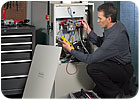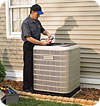
Welcome back to energy consciousness. Energy costs have gone up for both natural gas and electricity, putting a tighter squeeze on consumers. A new generation of kids is being scolded with, "Get your hands off that thermostat! Do you think we're made of money?"
Today's products strive to offer both simplicity of use and energy-efficient functions, such as setback and two-stage operation. They also offer the flexibility of multiple applications for contractors and IAQ features.
"I hear a lot from the consumer end," said Steve Klossner, technical director of the American Lung Association's Health House program. "They struggle with multiple controls, and in northern climates, there is an inability to respond to quick changes in temperature. They don't respond to the need to turn the thermostat up or down," he said.
Today's new residential controls help take care of "the complications involved in monitoring and controlling good IAQ," said Klossner. "It takes some of the onus off the consumer to manage these things."
THE ENERGY DRIVER
Jeff Holmquist, product specialist, thermostats - technical, Honeywell, said that this past summer saw electricity increases of up to 70 percent in some places. Many areas requested a rate increase through their public utility commissions.Increased natural gas prices already hit consumers last winter, but they also affect electric rates, said Ron Miles, vice president of sales and marketing - distribution, Emerson Climate Technologies, a business of Emerson. "Approximately 21 percent of electric utilities are fueled by natural gas."
"The homeowner doesn't use any more natural gas in the summer," said John Sartain, market manager for Emerson Climate Technologies. "But the utilities are using more natural gas." "Peaker plants" use natural gas instead of coal. "When utilities hit peaks, they fire up these plants," explained Sartain. "They fire up faster, but they aren't used all the time. Natural gas works for those situations."
"At the consumer level, energy saving is really about the temperature setback," said Pat Tessier, who leads Honeywell's thermostat group. "If you were adding dehumidification in summer, there are some soft savings there." A reasonably humid environment needs less heat for perceived comfort in the heating season.

SALES OPPORTUNITIES
"There is a direct correlation between rising energy costs and the incentive to learn to save energy," said Miles. "People paying higher bills were looking for a way to conserve energy.""Customers are interested in both simplicity and energy savings," noted Marc DeLaurent, split system product manager for Nordyne. "Most homeowners now want setbacks due to increased energy costs. It's a good time for contractors to capitalize on consumer energy concerns."
"There are two things going on," said Miles, "the rising cost of energy and conversion away from mechanical to programmable thermostats."
Sales opportunities for contractors are based on a real consumer need. "We saw a very strong demand for energy-saving thermostats already," Miles said. "We did some contractor meetings last fall; a lot of thermostats are sold on a service call or when a new furnace is put in. Last year, there were unsolicited calls to install a new thermostat.
"If contractors do a little marketing, they could take advantage of it," he said. "One or two postcards from contractors that would advertise setback thermostats or air cleaners would help. This winter won't be much different from last winter. I would think a little marketing on the contractor's part could pay off."
According to Sartain, "They tend to advertise the installed price of the unit, not the benefits. If they added information, the fact that consumers could save 10-30 percent on their heating bills, instead of just the installed prices, it would help."
"On a service call, there are always opportunities to upsell features," said DeLaurent. "The homeowner may want to upgrade their old mercury stat because it's outdated. They may want to upgrade to a higher efficiency programmable stat."
PROGRAM FEATURES
The built-in features of today's products make this task less daunting, Miles said. On the company's 90™ Blue™ touchscreen stat, for instance, "The displays are larger. Almost everyone has backlit display, and the characters are large. I'm in the 50-plus crowd," he continued. "I've got a sister who says, ‘Wow, I can see that without my glasses.' "The Blue stat, said Miles, "creeps up the set point by fractions of a degree without anyone having to do anything to the thermostat. The set point never actually changes on the thermostat. In the setup feature, you can decide on the rate of change from six different choices. As the runtime lengthens in the ‘on' cycle, you draw humidity out of the house. The house can stand a slightly higher set point temperature."
The system automatically prevents itself from running too long at peak-load conditions, Sartain said. "If your air conditioner has been running for 20 minutes or more, the thermostat will adjust the set point until it meets the room condition." The customer is still getting cooling and humidity reduction. "They feel comfortable even with the higher set point," Sartain said.
The impetus behind this product, he said, was personal experience. "My dad was a contractor, and way back when, we had an air conditioner that was oversized. When it was mild out we didn't get good cycles out of it. Here in St. Louis now, I would set it back to 85°F during the day and only went to 80° in the evening."
"Our engineers wrote the software to match up with his idea," said Miles. "The homeowner doesn't have to do a thing." The feature can be turned on or off. "It's still too early for contractor feedback," he said. "I think the biggest hurdle to overcome is actually explaining it."
DeLaurent said Nordyne's new 23 SEER product uses the iQ Drive, a communicating setback control that works in conjunction with the system. "This type of communication is becoming more and more common on higher-end systems. It's kind of what we saw happening to furnaces," he said.
"Now we're transferring that knowledge from the outside to the thermostat. The contractor doesn't have to go outside to take readings.
"We'd like to keep the consumer out of those fault codes," he said. "The codes are something the contractor knows how to access." They will not be made available to consumers.

USER INTERFACE
According to Tessier, Honeywell's Vision Pro thermostat is "very simple to use for consumers and contractors. The way that the screen was laid out was simple and easy to use. With its universal application, it could be applied to any type of a system."The company is now building upon those features, expanding the product to even broader applications. "From a consumer's perspective, it still looks and operates like a Vision Pro," he said. "We added an IAQ control; specifically, the device can now control a whole-house ventilator control a whole-house ventilator or some type of ventilation equipment. We built the ability to run efficiently according to ASHRAE 62.2, right into the product." ASHRAE Standard 62.2 specifies acceptable ventilation.
"You program the system with square footage, rooms, and how many cfm you want. The control takes over from there," Tessier said. The device also can control humidification and dehumidification.
The unit can be used in new construction and retrofit applications, he said. "How would you install [all those features] in a home that has few wires," Tessier asked. "This can be used in any application with heating and air as long as you have three wires." It works on four stages of heat and two of cool (two-stage heat pump plus two-stage furnace backup).
"It's the same Vision Pro interface," he said. "I don't think my wife knows the difference. If I had installed this new one while she wasn't home, she wouldn't have known the difference."
"I think contractors need to use both high-tech and simple products to enhance their image," he said. "Somebody's going to have to show the consumer how to use it. I really believe that with the newer touchscreen thermostats, the consumer can be taught to use it in five minutes."
The 90 Blue also is a touchscreen thermostat. It has focused attention on specific function buttons. "In the programming mode, for example, we get rid of all the other buttons that you see on the main screen," Miles said. "People have commented that it makes it a lot easier to use."
In addition, a one-button programming feature allows consumers to set up default programs for heating and cooling schedules. It changes settings for times of day and weekday automatically, said Sartain.
"We're trying to make sure people get the proper thermostat so they can exploit their features," said Tessier. The ideal thermostat for consumers these days probably includes setback and IAQ features, and the simpler, the better.
Publication date: 09/25/2006

Report Abusive Comment